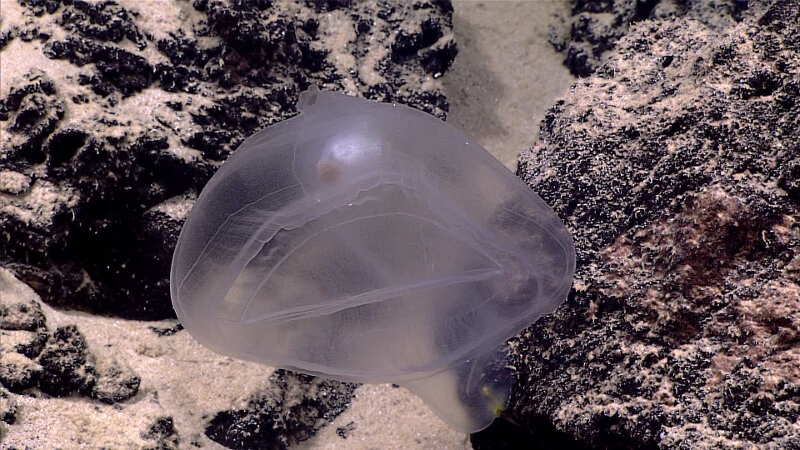
The predatory tunicate Megalodicopia sp. Image courtesy of the NOAA Office of Ocean Exploration and Research, 2016 Deepwater Exploration of the Marianas. Download larger version (jpg, 1.5 MB).

The predatory tunicate Megalodicopia sp. Image courtesy of the NOAA Office of Ocean Exploration and Research, 2016 Deepwater Exploration of the Marianas. Download larger version (jpg, 1.5 MB).
Deep-sea Holothurian
This deep-sea holothurian or sea cucumber, likely Paleopatides sp., was observed swimming on Dive 05 at Fina Nagu Caldera D. Deep-sea holothurians usually swim to avoid predation and physical danger. Video courtesy of the NOAA Office of Ocean Exploration and Research, 2016 Deepwater Exploration of the Marianas. Download (mp4, 34.6 MB)
Dive 5 took place at Fina Nagu Caldera D. The Fina Nagu (translates to "children of" in Chamorro, the language of Guam) Volcanic Chain is a series of calderas, none of which had been examined by remotely operated vehicle (ROV) or manned submersible for signs of hydrothermal activity or biological communities. Fina Nagu D is the southernmost of the three calderas that we are surveying on this expedition. Based on mapping data, we expect this to be the oldest caldera, and that features will be progressively younger as we move north. The ROV touched down in fresh-looking volcanics at ~3,030 meters, with light manganese-crust coatings and little sediment. We saw many lava morphologies on this dive, including pillow basalts, ropy lava, pieces of blocky talus, and sheet flows. In one area, we saw what looked like dikes. As we moved up the slope, we encountered scree slopes with moderate to heavy sediment and talus. Isolated small rock outcrops eventually transitioned almost entirely to outcrops (about 2,700 meters), with fewer talus pieces and less sediment. Toward the end of the dive, we reached an enormous pile of blocky talus that looked fresh and mostly unsedimented. We collected geological samples at the start of the dive, at the dike feature, and in the outcrops. We expected this site to have mature biological communities and were surprised by the dearth of animals here. Despite a low density of organisms, we saw a number of different animals, many of which are suspension feeders, including crinoids, sponges, and isidid and stylasterid corals. We encountered three potentially undescribed species of sponge, likely all Hyalonema spp., and we collected two of these. We also encountered a benthic siphonophore (dandelion), two swimming sea cucumbers (likely Paeleopatides sp.), a mating pair of amphipods, a benthic ctenophore, and a predatory tunicate (Megalodicopia sp). We transited a total of 750 meters upslope, ending at a depth of 2,692 meters.